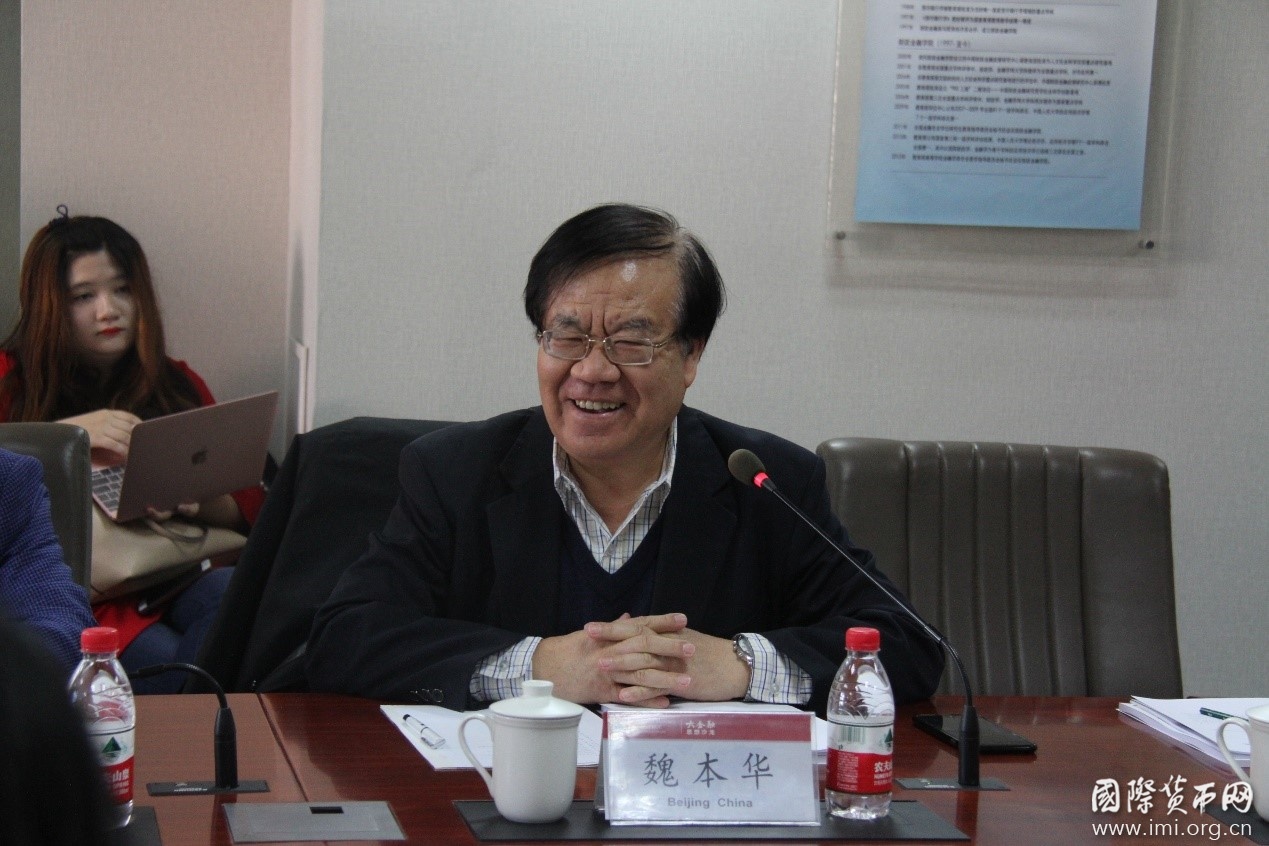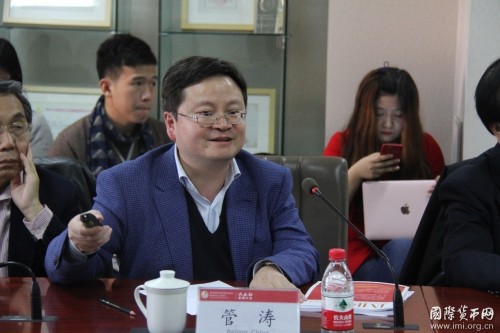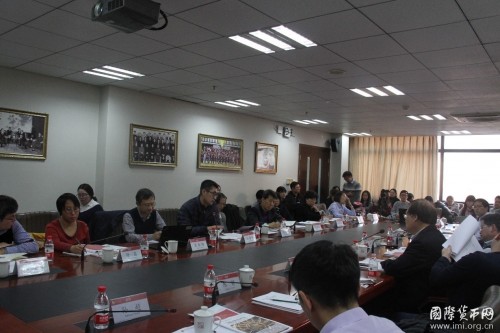Macro-Finance Salon (No. 74) Series of the 19th CPC National Congress (No. 1): The Reasons, Implications and Outlooks of RMB Appreciation in 2017
2017-11-18 IMI Based on the report of the 19th CPC National Congress, Guan Tao analyzed the causes and influence of RMB appreciation this year and provided an outlook of the future exchange rate policy. Guan Tao first reviewed the six stages of exchange rate changes this year and related policies. Since the end of last year, China has gradually stepped up its regulation of overseas mergers and acquisitions by enterprises, implemented stricter requirements of reporting personal foreign exchange uses and strengthened management of the outflow of cross-border renminbi. In the first half of this year, China has introduced the countercyclical factors in the pricing mechanism of RMB exchange rate. He pointed out that this year, the RMB exchange rate basically bounced back from its decline last year and the exchange rate rebound was realized when the foreign currencies were in short supply. This shows that the RMB appreciation is not the result of the supply-demand mechanism. Although RMB depreciated against non-US dollar currencies, under the dual pricing mechanism, the surprising weakening of the dollar made the renminbi stronger. From the angle of time, the major part of the appreciation occurred after the introduction of the counter-cyclical factor s at the end of May. From the angle of domestic and overseas markets, before August, renminbi appreciation was mainly caused by "overselling" in overseas markets, while appreciation in late August and early September was mainly driven by domestic market forces. From a micro angle, appreciation is itself a cause, and appreciation gradually shifts the market from being bullish on dollar to being bearish. From a macro perspective, a weak US dollar, strong Chinese economy and effective foreign exchange control policies are the factors that led to the appreciation of RMB this year.
Based on the report of the 19th CPC National Congress, Guan Tao analyzed the causes and influence of RMB appreciation this year and provided an outlook of the future exchange rate policy. Guan Tao first reviewed the six stages of exchange rate changes this year and related policies. Since the end of last year, China has gradually stepped up its regulation of overseas mergers and acquisitions by enterprises, implemented stricter requirements of reporting personal foreign exchange uses and strengthened management of the outflow of cross-border renminbi. In the first half of this year, China has introduced the countercyclical factors in the pricing mechanism of RMB exchange rate. He pointed out that this year, the RMB exchange rate basically bounced back from its decline last year and the exchange rate rebound was realized when the foreign currencies were in short supply. This shows that the RMB appreciation is not the result of the supply-demand mechanism. Although RMB depreciated against non-US dollar currencies, under the dual pricing mechanism, the surprising weakening of the dollar made the renminbi stronger. From the angle of time, the major part of the appreciation occurred after the introduction of the counter-cyclical factor s at the end of May. From the angle of domestic and overseas markets, before August, renminbi appreciation was mainly caused by "overselling" in overseas markets, while appreciation in late August and early September was mainly driven by domestic market forces. From a micro angle, appreciation is itself a cause, and appreciation gradually shifts the market from being bullish on dollar to being bearish. From a macro perspective, a weak US dollar, strong Chinese economy and effective foreign exchange control policies are the factors that led to the appreciation of RMB this year.
 Speaking of the impact of RMB appreciation this year, Guan Tao pointed out that the "811 exchange rate reform" solved the problem of lack of transparency in pricing, and after this, RMB appreciation this year resolved the problem of lack of credibility of the exchange rate policies under the floating regime and effectively suppressed the capital outflow. From the angle of velocity of unloading foreign currencies, this year corporate actions are slower than individuals’. The stabilization of the RMB exchange rate has created the conditions for easing foreign exchange controls. The alleviation of capital outflow pressure has contributed to the recovery of foreign exchange reserves. This shows that due to the downward rigidity of foreign exchange reserves, the much-debated option between "exchange rate" and "reserves"is not valid. To maintain exchange rate stability amid depreciation pressures means maintaining stable foreign reserves. From a trade perspective, the renminbi is basically depreciating against non-U.S. dollar currencies. However, the share of U.S. dollar in cross-border cash receipts and payments is falling, therefore renminbi appreciation does not help increase the competitiveness of the exporting industry. Instead, it is a financial shock.
Talking about the prospect of RMB exchange rate reform, Guan Tao believes that the RMB exchange rate is only restoring two-way fluctuations rather than returning to unilateral appreciation. Achieving a clean floating exchange rate is still the established goalof reform. The reform of the RMB exchange rate formation mechanism in terms of improving the exchange rate control mechanism, speeding up the construction of the foreign exchange market, and rationalizing the supply and demand of foreign currencies are still proceeding in an orderly manner. From the government's point of view, there is no painless solution. It is necessary to prepare for the worst by working out a plan based on scenario analysis and stress testingto achieve the best results. From the angle of the market, a market-oriented exchange rate is the trend of time. With the gradual withdrawal of the central bank from the normal intervention in the foreign exchange market, China will eventually move toward a new balance of international payments between trade surplus and outflow of capital. Capital outflow is a new normal.
Speaking of the impact of RMB appreciation this year, Guan Tao pointed out that the "811 exchange rate reform" solved the problem of lack of transparency in pricing, and after this, RMB appreciation this year resolved the problem of lack of credibility of the exchange rate policies under the floating regime and effectively suppressed the capital outflow. From the angle of velocity of unloading foreign currencies, this year corporate actions are slower than individuals’. The stabilization of the RMB exchange rate has created the conditions for easing foreign exchange controls. The alleviation of capital outflow pressure has contributed to the recovery of foreign exchange reserves. This shows that due to the downward rigidity of foreign exchange reserves, the much-debated option between "exchange rate" and "reserves"is not valid. To maintain exchange rate stability amid depreciation pressures means maintaining stable foreign reserves. From a trade perspective, the renminbi is basically depreciating against non-U.S. dollar currencies. However, the share of U.S. dollar in cross-border cash receipts and payments is falling, therefore renminbi appreciation does not help increase the competitiveness of the exporting industry. Instead, it is a financial shock.
Talking about the prospect of RMB exchange rate reform, Guan Tao believes that the RMB exchange rate is only restoring two-way fluctuations rather than returning to unilateral appreciation. Achieving a clean floating exchange rate is still the established goalof reform. The reform of the RMB exchange rate formation mechanism in terms of improving the exchange rate control mechanism, speeding up the construction of the foreign exchange market, and rationalizing the supply and demand of foreign currencies are still proceeding in an orderly manner. From the government's point of view, there is no painless solution. It is necessary to prepare for the worst by working out a plan based on scenario analysis and stress testingto achieve the best results. From the angle of the market, a market-oriented exchange rate is the trend of time. With the gradual withdrawal of the central bank from the normal intervention in the foreign exchange market, China will eventually move toward a new balance of international payments between trade surplus and outflow of capital. Capital outflow is a new normal.
 After the formal speech, member of IMI Academic Committee, president of Urumqi Central Sub-Branch, PBoC, Guo Jianwei; member of IMI Academic Committee, Director of CNIC Corporation Limited, Ltd., Sun Lujun; IMI Deputy Director, Tu Yonghong; IMI senior researcher Qu Fengjie, He Qing, IMI researcher Xiong Yuan, Xiu Jing, Lu Gaofei, Sun Chao, Jiang Nan participated in the roundtable discussion. They discussed the following issues: the influence of introducing counter-cyclical factors; the distortions of micro behaviors like bank running on foreign currencies; the relations between onshore and offshore market; how to prevent unilateral expectations; the normalization of interim intervention policies and the impact of the liberalization of the stock and bond market on foreign exchange market.
After the formal speech, member of IMI Academic Committee, president of Urumqi Central Sub-Branch, PBoC, Guo Jianwei; member of IMI Academic Committee, Director of CNIC Corporation Limited, Ltd., Sun Lujun; IMI Deputy Director, Tu Yonghong; IMI senior researcher Qu Fengjie, He Qing, IMI researcher Xiong Yuan, Xiu Jing, Lu Gaofei, Sun Chao, Jiang Nan participated in the roundtable discussion. They discussed the following issues: the influence of introducing counter-cyclical factors; the distortions of micro behaviors like bank running on foreign currencies; the relations between onshore and offshore market; how to prevent unilateral expectations; the normalization of interim intervention policies and the impact of the liberalization of the stock and bond market on foreign exchange market.
